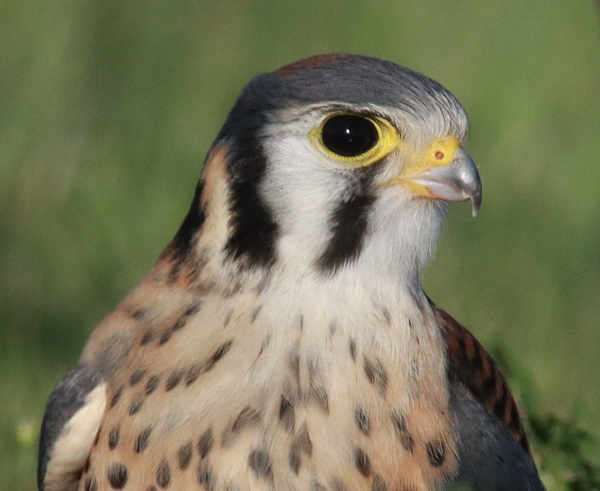
An inquisitive American Kestrel fledgling provided some close photo opportunities as it hunted on the ground and in the air.
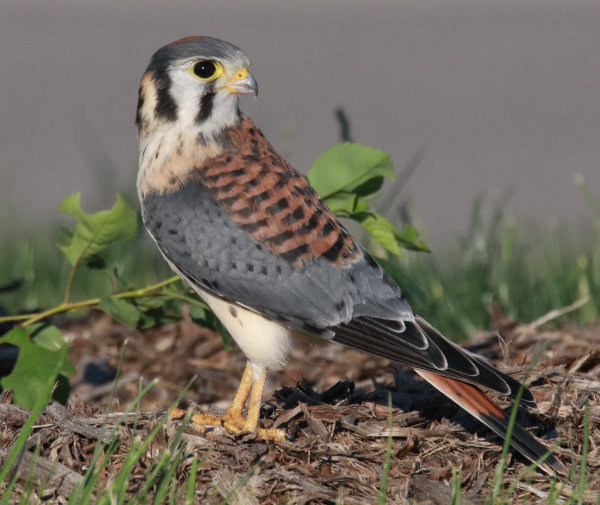
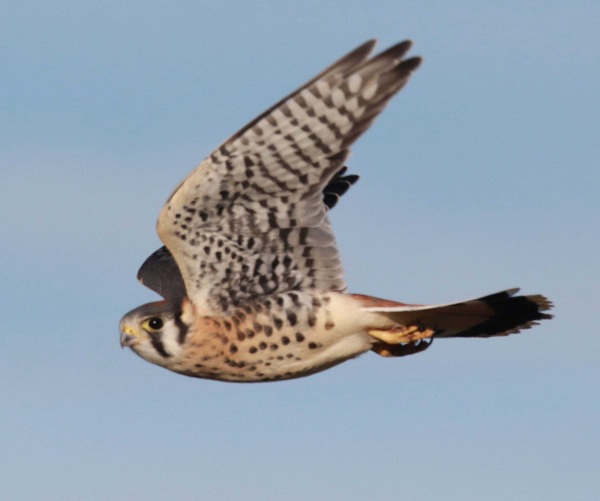
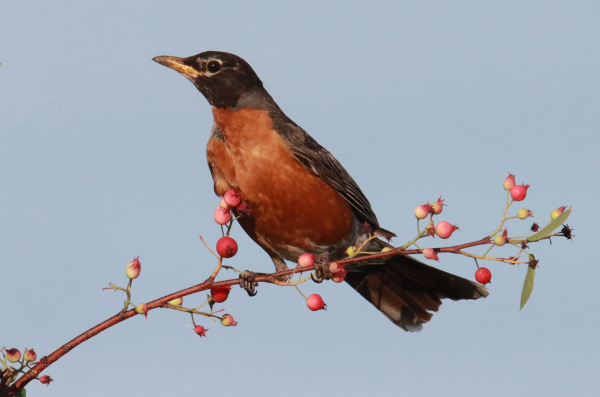
While photographing the kestrel, an American Robin landed nearby to harvest some ripening berries.
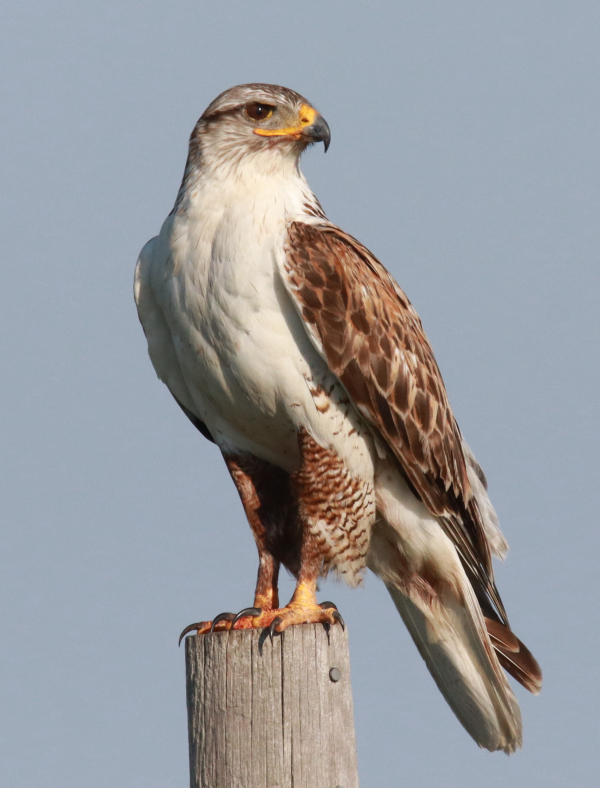
An especially trusting Ferruginous Hawk provided a chance to take portrait images that show front and back views of this large prairie raptor.
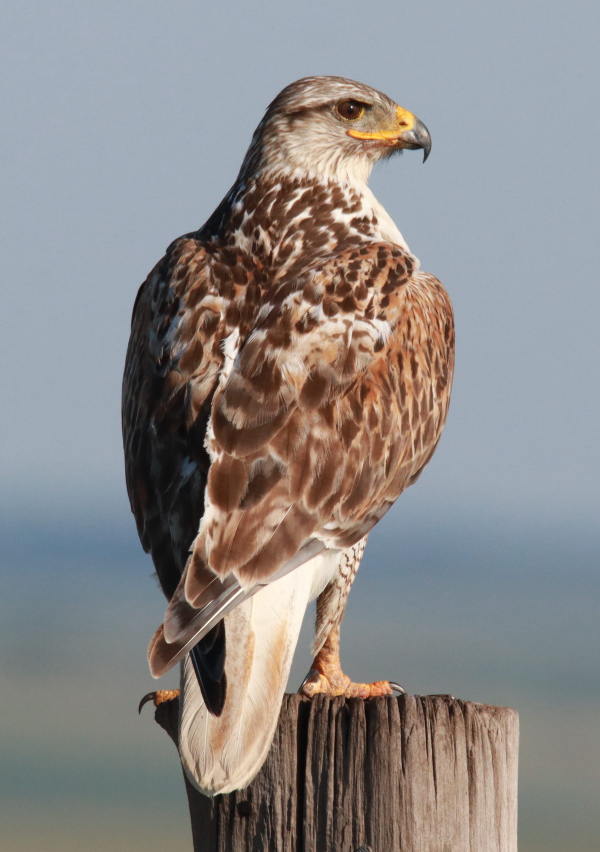
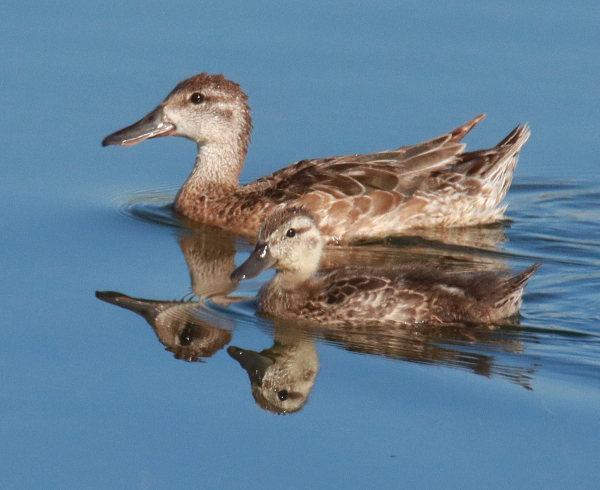
Blue-winged Teal broods have ranged in size from 2 to 12 ducklings this season, with more on the way. This female was accompanied by only 2 ducklings, including 1 that lagged behind.
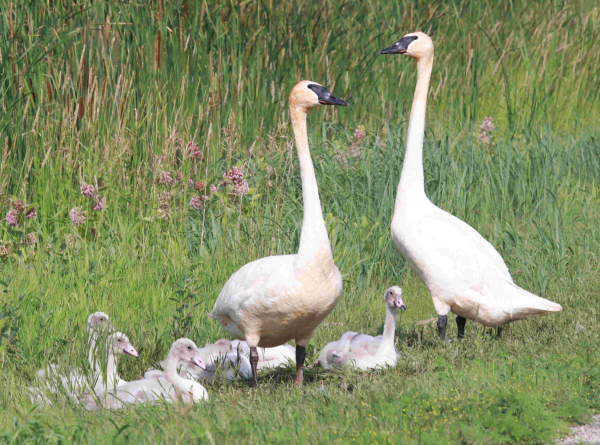
Not far from the loon lakes, a growing brood of 6 Trumpeter Swan cygnets relaxed in the shadows of the attentive adults. Eastern Bluebirds were especially abundant in the area too.
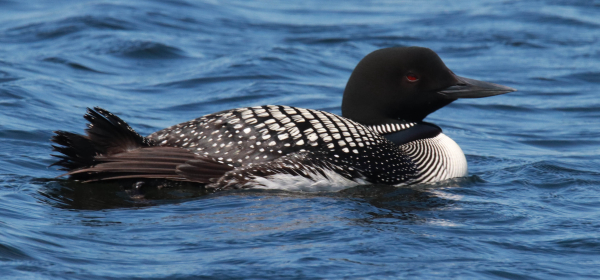
The color and texture of the water is always an interesting ingredient in waterbird photographs, and the relaxed demeanor of this Common Loon adds another dimension to this summer image.
|
Over the early July vacation period I managed to do some birding in 4 states, driving west to the Badlands in western North Dakota and checking a couple locations across the border in Montana. It’s amazing how different western North Dakota is from my home turf, even though it’s only 250 miles away. Then I crossed the border that divides the Dakotas to do a little birding in the midst of Hecla Marsh. And finally I headed 200 miles northeast to the forest and lakes country of west-central Minnesota for a water-based birding cruise with my friend Andy.
Highlights of birds sighted included Mountain Bluebirds, Spotted Towhees, Lazuli Buntings, Lark Sparrows, and Turkey Vultures in Theodore Roosevelt National Park deep in the Badlands; with Lakes Country in Minnesota yielding exciting observations of Common Loons, Ospreys, Trumpeter Swans, a Great Crested Flycatcher, Belted Kingfishers, and Bald Eagles among others. Hecla Marsh revealed Western Grebes with varied sizes of hatchlings, 2 nesting pairs of Black-necked Stilts, and about 40 post-nesting adult American Avocets; Sedge Wrens, a few broods of Mallards and Blue-winged Teal, and several Ring-necked Pheasants. These highlighted birds are a few among the many birds that form the basis for each of these different environs.
I spent most of my time at home though, working on a list of fix-up/clean-up projects and breaking away to the surrounding area for local birding opportunities. Home range highlights included an abundance of new duck broods, the arrival of more migrating shorebirds in transit from their nesting to wintering ranges; plus fledging and post-fledging raptor observations. Local birding continues to be top-notch!
Raptor Observations & Photos
It’s always worthwhile to check back on nest sites on an annual basis, to see if a pair is on territory; and later, to document if a nesting attempt is successful and to gather any other information, including the number of fledglings. That was my point of interest when I revisited a nesting territory where I observed and photographed a pair of American Kestrels with 4 fledglings at the end of June last summer. During an early spring check, an adult male was on hand, but would there be any evidence of nesting on July 5th? At first, the open area was devoid of all birds, but suddenly I spied a kestrel perched about 15 feet high.
Excited to see one of the mini-falcons in what was a post-fledging area last year, I settled in to watch for more kestrel activity. Almost immediately, another kestrel flew into view holding apparent prey in its talons – probably an adult with prey to offer to a fledgling or fledglings. Sure enough, 2 more kestrels flew in to shadow the adult male, calling (food begging) all the way. Moments later there were 5 kestrels in sight, including at least 1 female fledgling, but I didn’t get a true idea of the sex of all the fledglings. I did what I could to photograph the American Kestrels, but they weren’t very helpful, and I had 3 things I needed to do in a short period beyond the kestrel territory. It was also earlier in the afternoon than I like to photograph – and it was terribly windy.
Therefore, I decided to take care of Fargo business and return asap, hopefully when the wind subsided a bit. At that time, the stout wind showed how well the young falcons were flying – they appeared to be quite masterful in zooming around in the wind, tilting and zipping sideways, up, down, and all around. This brood of kestrels clearly fledged a week or so earlier to be such good aerial masters. So the next question was: How well was their hunting progressing? When I returned a couple hours later, the angle of the sun was much better (lower in the west), there was still considerable wind, but it was reduced nonetheless. However, there was no sign of a kestrel, much less a family group. Did I make a strategic mistake by postponing my observations?
I covered a much larger area before circling back to the location where the kestrels were active earlier, and as I slowly circled the area, a kestrel suddenly flew into view, just beyond the driver’s side window of my car. I quickly scrambled to photograph the kestrel as it faced into the wind on the wing. It was rewarding to see it turn in a fairly tight circle and land on a nearby sign with its eyes focused in on my car, or my camera lens, or both – it was inquisitive nonetheless. The fledgling moved a little closer with a few wingbeats and dropped down to the ground, close. There it began searching for food, bugs would be my guess; large insects provide good protein while fulfilling the role of prey for the new fledglings to practice hunting skills.
As the young kestrel searched an area covered with grass and mulch beneath a small tree I followed its activities to take photos when the mini-flacon presented a pleasing image. It was also personally rewarding to have the young raptor not only accept my presence, but to approach so closely in the first place. This would be my best chances to observe and photograph any of this year’s brood during that day’s double visits, and another stopover 4 days later when I observed 1 and 2 kestrels at a time in the post-fledging area.
In addition to checking on the kestrel family, I similarly checked back on my Ferruginous Hawk nest sites between 25 and 30 miles northwest of home. The closer nest site has been abandoned for several weeks; apparently the nesting attempt failed about the time the eggs should have hatched or shortly thereafter. The other Ferrug pair has been successful in raising 3 nestlings to fledging, and a week ago Tuesday all 3 fledglings were perched just beyond the nest – they were branchers, soon to begin flying beyond the nest and beginning the post-fledging period, probably in the area surrounding the nest site.
Most exciting though, was the presence of the large adult female that I found perched on a fence post adjacent to the road. To try a photo, I needed to drive past the big hawk to get between the sunlight and the hawk without flushing it – and it worked! I began photographing as soon as I braked and turned off the car’s ignition, so happy the Ferrug was so trusting, even as I photographed her. Last year I had the experience of photographing an equally big female Ferruginous Hawk, possibly perched on the same post, and she turned out to be very trusting – and I have no doubt that judging by this behavior that this was the same female occupying the same nest and raising 3 more fledglings with her mate.
After a few minutes, the female did take flight, simply moving down the fenceline to another wooden post, so after giving her a minute or so to settle in, I approached her again, this time not needing to pass her (the sun was already positioned at my back). It was nice to see that the big hawk had her back turned toward me, which provided a view of the plumage that covered its back, wings, and whitish tail. (In case you are new to my explanation of the word ferruginous, it is a shade of orange, and relates to the orangish color of some of this hawk’s plumage, especially its leg feathers.)
I checked back 2 days later without seeing an adult Ferruginous Hawk, but Saturday evening I found both adults perched along the side of the very rural gravel road. The female was most trusting again, but the male proved to be equally trusting as I photographed each bird without disturbing them or the 3 near-fledglings that were standing on the nest rather than perched in adjacent branches as they were during earlier visits last week.
Duck Broods & Migrating Shorebirds
Duck broods continue to dominate area marshes, with Blue-winged Teal broods outnumbering all the others now, including broods of Mallards, Northern Shovelers, Northern Pintails, and Redheads, with the first Gadwall broods appearing last week. I also spied the first Ruddy Duck brood of 7 Sunday evening.
New shorebirds have been appearing during July, migrating from nesting ranges to the, and Bobby’s Bay continues to be the first place to check for new birds. The first few Pectoral Sandpipers and Least Sandpipers were present on July 4th, 7 Stilt Sandpipers were on hand July 6th, and the first Long-billed Dowitchers appeared on July 7th. After a first sighting, species numbers tended to grow, sometimes quickly. For example, last Sunday about 60 Long-billed Dowitchers were present with about 70 Stilt Sandpipers and 25 Least Sandpipers; there were also a few Least and Pectoral Sandpipers and Greater Yellowlegs.
An unexpected pair of Black-necked Stilts was present among a small variety of shorebirds at a location about 24 miles west-northwest. A rare sighting of a Virginia Rail was tops among wading birds, although it provided just a brief look (I usually only see 1 Virginia Rail per summer owing to their secretive nature and the ability to remain out of sight among the vegetation of area marshes). And then there were the Common Loons of Minnesota: I recount my latest loon observations and insights while sharing the best photos from another outing on the Pelican Lakes in the Detroit Lakes area of Minnesota in this issue’s Bird Photography feature in this issue of The Birding Wire.
Feeder Action
Orchard Orioles continue to be very active at my jelly feeders, and it’s clear that at least one pair is feeding nestlings in their nest a short distance west of home, but there may be 2 pairs. I’m hoping to see fledglings come to my feeders soon, after all, Orchard Orioles only remain in the nest about 14 days. Speaking of fledglings, they strongly resemble females in color, although their new plumage tends to be a bit brighter. In the field, Sunday I observed an adult male Orchard Oriole and at least 5 “yellow” Orchards at once, indicating a female and 4 fledglings in a family group foraging in an area about 11 miles south of my office, where Orchard Orioles nest annually.
Baltimore Orioles have been especially rare visitors, with only one to be seen so far during July – the yellow-and-black male fed on grape jelly July 8th, when I could see that it was noticeably molting. One or more male Ruby-throated Hummingbirds continue to make very sporadic visits, sometimes for nectar but more often to check for small insects near or on the feeders, but I haven’t seen a female during July. Sunday I observed a male take several sips of nectar at my feeder about noon, and Monday I made a similar observation near the end of the day.
A couple young American Robins continue to visit occasionally for jelly, but adult robins are regular jelly feeders, probably due to a second nesting attempt. Actually, a pair of robins nested above my car parking spot and raised 3 fledglings in June, and a week ago I noticed a robin incubating in the nest again – perhaps the same pair, perhaps not; but another young brood is being fed now. Of course, as soon as I reported that Gray Catbirds moved on (in the last issue), 1 appeared again, and I see 1 sporadically, but not daily. House Finches are regular visitors, and a male American Goldfinch brightened up the feeding station after a morning rain Friday.
Just as it was a super spring season in my area of the northern Great Plains, summer shows signs of being one of the best too. I hope you are having a rewarding birding season, and wish you Good Luck as you enjoy the birds around you – at home, in the field, and as you travel.
Article and Photos by Paul Konrad
Share your bird sightings and photographs at editorstbw2@gmail.com